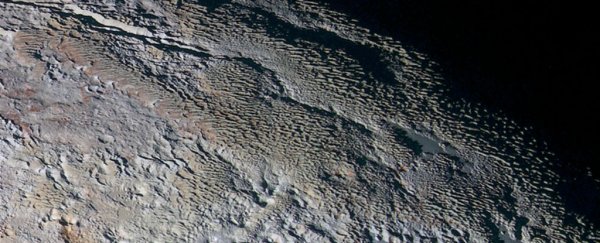It took NASA's New Horizons space probe almost a decade to trek its way across the Solar System for 2015's historic Pluto flyby – and when it got there, it discovered stunning towers of ice reaching 500 metres into the sky.
This is the first time this phenomenon has been found anywhere in the Solar System other than on Earth, and now, a new analysis of those ridges has identified the atmospheric process that caused them to form.
The distinctive bladed terrain you can see in the image above makes up part of Pluto's Tartarus Dorsa region, which New Horizons flew over in July 2015.
The ridges in the image are called penitentes and can be found at high altitudes on Earth, taking the shape of towers – or blades – of hardened snow or ice, all angled together in the general direction of the Sun.
The formations get their name from the act of being penitent – as their appearance resembles a congregation of people kneeling in penance – and now, thanks to research led by engineer John Moores from York University in Canada, we've got the first evidence of them occurring somewhere other than Earth.
 Penitentes at the Atacama Desert in Chile. Credit: ESO/B. Tafreshi
Penitentes at the Atacama Desert in Chile. Credit: ESO/B. Tafreshi
When NASA first analysed the tower images it was receiving from New Horizons, it's clear the researchers didn't quite know what to make of the shapes, calling them "intricate but puzzling patterns of blue-grey ridges and reddish material in between".
That lack of familiarity isn't so surprising when you consider that Pluto's ice ridges are massive towers standing up to 500 metres in height – making them hundreds of times taller than the Earth-bound versions, which usually only extend about a metre vertically (although outliers reach up to 5 metres or 16 feet).
But when Moores and his team ran computer modelling of Pluto's atmospheric conditions, the simulations reproduced the penitentes as New Horizons documented them – and that could help us understand why we haven't observed these towers taking shape elsewhere in the Solar System.
"The identification of the ridges of Tartarus Dorsa as penitentes suggests that the presence of an atmosphere is necessary for the formation of penitentes, which would explain why they have not previously been seen on other airless icy satellites or dwarf planets," says Moores.
"But exotic differences in the environment give rise to features with very different scales."
In Pluto's case, the temperature is much colder than on Earth, and the atmosphere is much thinner, but the same physical principles apply.
Penitentes are formed by erosion, where ice sublimates in very cold conditions, turning into water vapour directly, rather than melting into a liquid.
 NASA/JHUAPL/SwRI
NASA/JHUAPL/SwRI
The penitentes on Pluto are made up of methane and nitrogen instead of water, but despite their massive scale, it's the same sublimation process as on Earth.
"This gargantuan size is predicted by the same theory that explains the formation of these features on Earth," says Moores.
"In fact, we were able to match the size and separation, the direction of the ridges, as well as their age: three pieces of evidence that support our identification of these ridges as penitentes."
Scientists have previously speculated that penitentes may exist on Jupiter's moon, Europa, but this is the first time the phenomenon has been confirmed elsewhere in the Solar System.
And now that we know it's happening on Pluto, the researchers say their modelling technique could help us to determine on which other worlds it might be happening too – both near and far.
"This test of our terrestrial models for penitentes suggests that we may find these features elsewhere in the Solar System," says Moores, "and in other solar systems, where the conditions are right."
The findings are reported in Nature.
